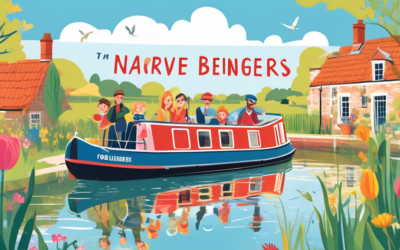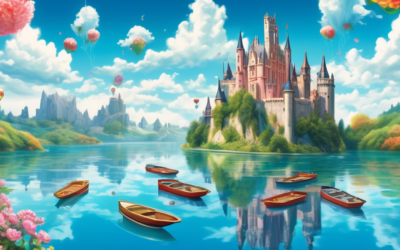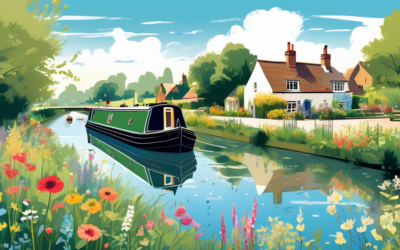The Evolution of Canal Boats Through History
Canal boats, those enchanting vessels that meander through the intricate maze of the United Kingdom’s waterways, have a rich history that is often overlooked. Today, these boats are synonymous with leisurely holidays, tranquil explorations, and a unique way of living. However, their story begins in an entirely different context, rooted deep in the necessities of the Industrial Revolution. From the robust working boats of the 18th century to the delightful holiday cruisers seen today, canal boats have undergone an incredible transformation.
The Birth of the Canal Boat
The origin of canal boats in the UK is intrinsically linked to the Industrial Revolution in the late 1700s. This period saw a dramatic increase in the need for efficient transportation methods for goods. Roads were in poor condition, and traditional means of transport were no longer viable for the heavy and bulk goods industry produced. Enter the canal boat, an innovation that revolutionized transport and played a crucial role in the industrial expansion of Britain. The construction of extensive canal networks like the Four Counties, Cheshire Ring, and the famous Llangollen Canal in the north-west of England marked the beginning of this era.
The Working Boats of Yesteryears
Initially, canal boats were workhorses, designed to transport coal, textiles, pottery, and raw materials across the country. They were narrow, to fit the slender canal locks, yet incredibly efficient, capable of carrying significant loads. These boats were powered initially by men or horses walking along the towpaths, and later by steam and diesel engines, dramatically increasing their efficiency. One can still find remnants of these times along the pathways that criss-cross the north-west of England, where towpath walkers tread the same ground once traversed by the horses that pulled the narrowboats.
The Families Who Lived Onboard
An often unackreciated aspect of canal boats’ history is the unique lifestyle of the families who lived and worked on them. In the heyday of the working boats, entire families would live in the cramped quarters of their vessel, dedicating their lives to the transportation of goods. These boats were more than just a means of transport; they were homes, with their peculiar culture and traditions. The close-knit nature of these boating families and their way of life has left a lasting legacy on the canal culture in the UK.
The Transition to Diesel Engines
The transition from human and horse propulsion to steam engines marked the first significant evolution of the canal boat, but it was the advent of the diesel engine that would secure their place in history. Diesel engines, introduced in the early 20th century, offered a more efficient, cleaner and simpler solution for powering boats. This technological advancement coincided with the gradual decline of commercial canal transport, as railways and roads began to dominate logistics and transport in the UK.
The Resurgence as Leisure Vessels
As commercial use of canal boats waned, the mid-20th century saw a remarkable transformation of these waterways and their vessels. The rise of leisure cruising and the burgeoning houseboat community breathed new life into the canals. Ancient commercial waterways, including the Four Counties, Cheshire Ring, and Llangollen Canal, were rediscovered by enthusiasts as tranquil retreats from the hustle and bustle of modern life. Canal boats were refitted for comfort, with the addition of amenities like kitchens, bathrooms, and living spaces, making them perfect for holiday cruises or alternative living arrangements.
Canal Boats Today
Today, canal boats retain their charm and appeal, offering a unique way to explore the picturesque landscapes of the north-west of England and beyond. The narrowboats of today come in various shapes and sizes, catering to the holidaymaker seeking a tranquil escape or the adventurous soul contemplating a life afloat. The canals, once the highways of the Industrial Revolution, are now the scenic backdrop for a leisurely pace of life, far removed from their industrial origins.
The Future of Canal Boating
Looking forward, the era of the canal boat is far from over. With growing interest in sustainable and slow tourism, canal boats offer an appealing alternative to mainstream holiday options. Innovations in electric propulsion and environmentally friendly technologies promise a new chapter in the evolution of these historic vessels. The stories of the canals and their boats continue to captivate, ensuring that this unique aspect of British heritage thrives for generations to come.
Final Thoughts
The canal boats of the UK, from their inception as the workhorses of the Industrial Revolution to their current status as cherished leisure vessels, have undergone a profound evolution. They have adapted and transformed, overcoming the risk of obsolescence to emerge as beloved icons of the British waterways. For anyone embarking on a journey along the storied canals of the north-west, like the Four Counties, Cheshire Ring or the Llangollen Canal, these boats are not just a mode of transportation but a vibrant piece of history, inviting exploration of a bygone era and a slower, more thoughtful way of life.
Fancy a boat holiday – Check out Floating Holidays fleet for hire!






0 Comments